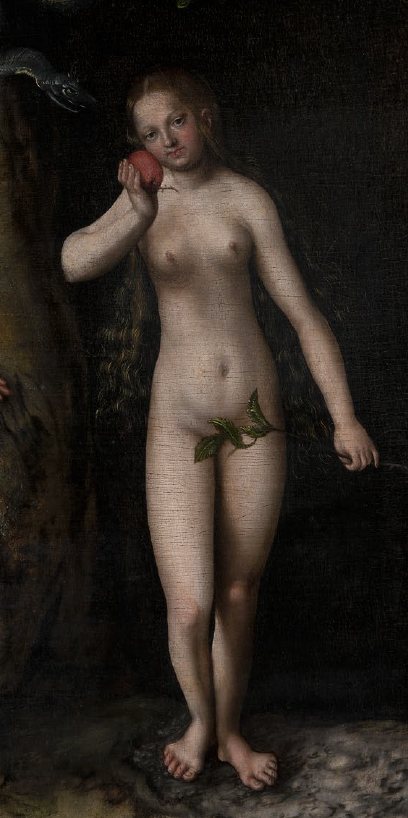Abstract
The paper presents the results of the latest technological research on Lucas Cranach the Elder’s painting Adam and Eve from the collection of the National Museum in Warsaw. The tests were conducted using non-destructive or micro-invasive physical and chemical methods. The painting was analysed under analytical radiation within ultraviolet (UV), visible (VIS), infrared (IR) and X-ray (X-ray, CT) wavelength ranges. To examine the composition of the paint layers, the authors employed X-ray fluorescence spectroscopy (XRF), reflectance Fourier-transform infrared spectroscopy (FTIR), Fourier transform infrared-attenuated total reflectance spectroscopy (FTIR-ATR), gas chromatography coupled with mass spectrometry (GC/MS), liquid chromatography coupled with mass spectrometry (LC/MS), Raman microscopy, as well as microchemical and stratigraphic analyses. These tests enabled a highly detailed identification of the painting technique, facilitated a comparison with Lucas Cranach the Elder’s other works and provided a solid basis for a more in-depth argument regarding the painting’s creation date.
References
Alessia Andreotti et al., ‘Combined GC/MS Analytical Procedure for the Characterization of Glycerolipid, Waxy, Resinous, and Proteinaceous Materials in a Unique Paint Microsample’, Analytical Chemistry, vol. 78, no. 13 (2006), pp. 4490–4500.
Benesz Hanna, ‘Temat na pokuszenie’, Art&Business, no. 11 (262) (2012), pp. 82–83.
Braune Heinz, Wiese Erich, Katalog der Gemälde und Skulpturen. Schlesisches Museum der Bildenden Künste Breslau (Wrocław, 1926).
Cennini Cennino, Treatise on Painting, tr. Mary P. Merrifield (London, 1844) [online facsimile]: https://archive.org/details/gri_33125009350998/page/n15/mode/2up [retrieved: 10 Mar. 2025]
Colombini Maria Perla et al., ‘Analytical strategies for characterizing organic paint media using gas chromatography/mass spectrometry’, Accounts of Chemical Research, vol. 43, no. 6 (2010), pp. 715–727.
Cranach Digital Archive, https://lucascranach.org/ [retrieved: 26 Nov. 2024].
Friedländer Max J., Rosenberg Jakob, The Paintings of Lucas Cranach (New York, 1978).
Grimm Claus, ‘Die Anteile von Meister und Werkstatt. Zum Fall Lucas Cranach d. Ä.’, in Unsichtbare Meisterzeichnungen auf dem Malgrund. Cranach und seine Zeitgenossen, ed. Ingo Sandner (Regensburg, 1998), pp. 67–82.
Heidenreich Gunnar, Lucas Cranach the Elder. Painting materials, techniques and workshop practice (Amsterdam, 2007).
Heydenreich Gunnar, ‘Adam and Eve in the Making’, in Temptation in Eden. Lucas Cranach’s Adam and Eve, ed. Colin Campbell, exh. cat., Courtauld Institute of Art Gallery, Somerset House (London, 2007), pp. 18–33.
Iwanicka Magdalena et al., ‘Complementary use of Optical Coherence Tomography (OCT) and reflection FTIR spectroscopy for in-situ non-invasive monitoring of varnish removal from easel paintings’, Microchemical Journal, vol. 138 (2018), pp. 7–18.
Organic Mass Spectrometry in Art and Archaeology, eds Maria Perla Colombini, Francesca Modugno (Chichester, 2009).
Rampazzi Laura et al., ‘Non-invasive techniques for revealing the palette of the Romantic painter Francesco Hayez’, Spectrochimica Acta Parta A: Molecular and Biomolecular Spectroscopy, vol. 176 (2017), pp. 142–156.
Rosi Francesca et al., ‘Micro transflection on a metallic stick: an innovative approach of reflection infrared spectroscopy for minimally invasive investigation of painting varnishes’, Analytical and Bioanalytical Chemistry, vol. 409 (2017), pp. 3187–3197.
Rudniewski Piotr et al., Pigmenty. Analiza mikrochemiczna i instrumentalna, Academy of Fine Arts in Warsaw (Warsaw, 2018).
Schade Werner, Malarski ród Cranachów, tr. Ewa Żakowska (Warsaw, 1980).
Schawe Martin, Cranach in Bayern, exh. cat., Bayerische Staatsgemäldesammlungen, Alte Pinakothek, 2011 (Munich, 2011).
Steinborn Bożena, ‘Obrazy Cranachowskie’, in Nobile claret opus. Studia z dziejów sztuki dedykowane Mieczysławowi Zlatowi, eds Lech Kalinowski, Stanisław Mossakowski, Zofia Ostrowska-Kębłowska (Wrocław, 1998), pp. 45–49.
Steinborn Bożena, Ziemba Antoni, Malarstwo niemieckie do 1600 roku. Katalog zbiorów / Deutsche Malerei bis 1600. Bestandskatalog, National Museum in Warsaw (Warsaw, 2000), cat. no. 8, pp. 44–47.
Vahur Signe et al., ‘ATR-FT-IR spectral collection of conservation materials in the extended region of 4000-80 cm–1’, Analytical and Bioanalytical Chemistry, 408 (2016), pp. 3373–3379.
Witkowski Bartłomiej et al., ‘Identification of proteins, drying oils, waxes and resins in the works of art micro-samples by chromatographic and mass spectrometric techniques’, Journal of Separation Science, vol. 41, no. 3 (2018), pp. 630–638.
Wood Christopher S., Albrecht Altdorfer and the Origins of Landscape (Chicago, 1993).
Ziemba Antoni, ‘Lucas Cranach starszy, Adam i Ewa’ [catalogue entry], in Dorota Folga- Januszewska, Matthias Winzen et al., Das Heilige und der Leib. Schätze aus dem Nationalmuseum Warschau / Duchowość i cielesność. Skarby Muzeum Narodowego w Warszawie, exh. cat., Staatliche Kunsthalle, Baden-Baden, National Museum in Warsaw (Ostfildern-Ruit, 2005), p. 90.

This work is licensed under a Creative Commons Attribution 4.0 International License.
Copyright (c) 2024 Tomasz Gierczak, Aleksandra Janiszewska-Cardone, Justyna Kwiatkowska, Elżbieta Pilecka-Pietrusińska, Olga Syta, Barbara Wagner, Bartłomiej Witkowski, Magdalena Wróbel-Szypula (Autor)


